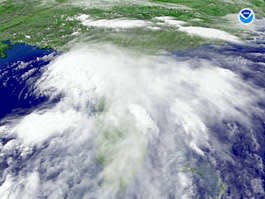Will May heat bring more tropical storms? Officials mull moving start of hurricane season
Hurricane Alex Wasn't a particularly big storm back in 2016, or one that will be remembered for its ferocity or track, which threatened little more than shipping routes out in the Atlantic.
In fact, it was a pretty mundane storm except for one very unusual factor: it formed in January, five months before the June 1 “official” start of the Atlantic hurricane season.
In the five years since then, the first named storm of the hurricane season has developed weeks before June 1. While these storms generally aren’t very powerful, and could be being picked up by researchers because of better tracking techniques thanks to more advanced technology, it still represents a consistent trend of storms forming before the official start of hurricane season.
Cat 6 hurricanes? In a warming world, 'Cat 6' hurricanes could soon be coming to a coast near you
The threshold for a “named” tropical storm is 39 mph. It becomes a hurricane when its sustained winds reach 74 mph on the Saffir-Simpson Hurricane Wind Scale.

Climatologists are in general agreement that climate change, largely driven by human's pumping heat-trapping greenhouse gases into the atmosphere, is leading to more frequent, powerful and dangerous hurricanes as the planet warms. That’s prompted increased discussions among meteorologists about moving the official start of hurricane season up, with sometime in early to mid-May a popular new start date.
Dr. Michael Mann, director of the Earth System Science Center at Penn State University, supports the idea of being more flexible when thinking about when hurricane season starts to “arguably avoid the artificial notion of a fixed storm season altogether.”
Remembering Hurricane Bertha at 25: The storm that opened coastal North Carolina's eyes
“Just like the notion of fire seasons out West, it’s becoming less and less appropriate as the seasonal window during which these events (tropical storms and hurricanes in this case) occur grows wider,” he said via email.
Among the notable storms that have formed in May in recent years, although none have reached hurricane strength, include 2018’s Tropical Storm Alberto, which caused heavy flooding and took eight lives in Western North Carolina and Virginia as it plowed up the Ohio Valley from the Gulf of Mexico.

But while the National Hurricane Center (NHC) formed a team last year to study the idea, and has started issuing routine Atlantic tropical weather outlooks on May 15, no immediate changes are planned.
“While this team continues its work, no changes to the start of the Atlantic hurricane season will occur in 2022,” said NHC spokesman Dennis Feltgen by email.
Dr. Lian Xie, professor of marine, earth and atmospheric sciences at N.C. State University, agrees with keeping the start of hurricane season June 1.
He said residents in coastal states need to be reminded that June 1 is not the “natural start date” of hurricane season, but just when tropical storm formation in the Atlantic gets busier.
“Likewise, we have also seen tropical storms and hurricanes develop after the Nov. 30 end date of the official hurricane season,” Xie said via email. “We do not need to change the end date, either.”
See the damage: Remembering Hurricane Fran at 25 in Photos
As in recent years, and what's likely to be the case regularly moving forward if climatologists are to be believed, researchers are forecasting another active Atlantic hurricane season in 2022.
The Tropical Meteorology Project Team at Colorado State University is projecting nine named storms between June 1 and Nov. 30. Of those, CSU researchers expect nine to become hurricanes and four to reach major hurricane strength, which is Category 3 or stronger.
The team predicts that 2022 hurricane activity will be about 130% of the average season from 1991-2020. By comparison, 2021’s hurricane activity was about 120% of the average season. The researchers also are predicting the following landfalling potential for a major hurricane on the U.S. mainland:
71% for the entire U.S. coastline (average for the last century is 52%)
47% for the U.S. East Coast including the Florida peninsula (average for the last century is 31%)
46% for the Gulf Coast from the Florida panhandle westward to Brownsville (average for the last century is 30%)
Reporter Gareth McGrath can be reached at GMcGrath@Gannett.com or @GarethMcGrathSN on Twitter. This story was produced with financial support from 1Earth Fund and the Prentice Foundation. The USA TODAY Network maintains full editorial control of the work.
This article originally appeared on Wilmington StarNews: Should the start of hurricane season move up due to climate change?

